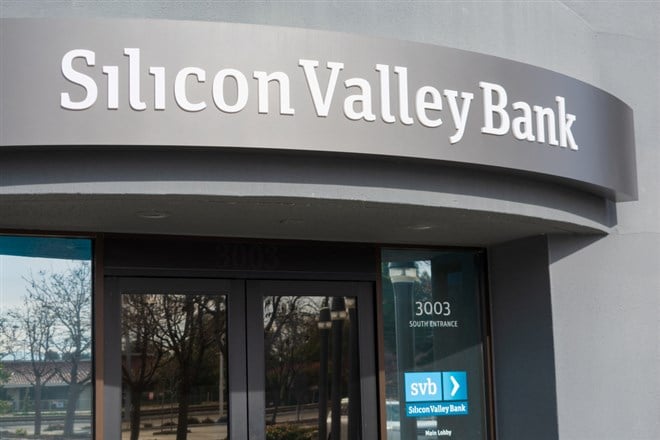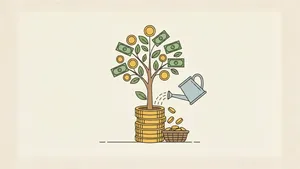
Friday was supposed to be about the February jobs report and its impact on Fed rate hikes — but SVB Financial Group (NASDAQ: SIVB) stole the show.
Financial regulators closed the nation’s 16th largest bank, a mere two days after the company raised capital and sold assets below cost. The FDIC’s swift takeover of a bank that had $209 billion in assets at year end marked the biggest U.S. bank failure since Washington Mutual was seized in September 2008.
Silicon Valley Bank’s demise dealt a devastating blow to venture capital (VC) groups who represented a major part of the bank’s client base. VC’s were already hurting from higher rates and an IPO market slowdown that made it harder to raise funds.
It is also a dagger for shareholders who had seen $500 slashed from SVB’s share price since November 2021. Trading in the stock was halted on March 10th, 2023 after it plunged 60% the previous day. Wall Street research group Maxim then commented that SVB stock has “likely no value.”
The ripple effects are expected to go beyond those that had close ties to SVB. For starters, there is likely to be more intense regulatory scrutiny of regional banks regardless of size or stature. As government officials sift through the wreckage, steps to enact new legislation that prevents similar collapses will likely follow.
How Did the SVB Financial Meltdown Occur?
Soon before the FDIC stepped in, SVB was forced to sell most of its available-for-sales securities at a loss to offset a drop in customer deposits. It announced a $2.25 billion capital raise to offset the situation but it was too little too late. How did things even get to this point?
Silicon Valley Bank had been in business for 40 years as a lender to some of the technology sector’s biggest companies. But that didn’t make it immune to economic pressures.
Customer deposits tripled from 2018 to 2021 when interest rates were low and tech startups were cash-rich. But when rates soared in 2022, the VC market slowed to a crawl as did deposit activity at SVB. Things were made worse when the bank invested what funds it did receive in bonds that would later lose value as rates climbed.
In the end, it was SVB’s decision to invest a high portion of customer deposits in bonds and mortgage-backed securities (MBS) that quickly deteriorated in value. Things reached a boiling point after the bank suffered a nearly $2 billion loss from selling securities and turned to the capital markets for help. VC funds advised companies to pull their SVB deposits, setting the stage for the stock selloff and regulatory intervention.
Will Customers’ Bank Deposit Behavior Change?
SVB Financial held more than $175 billion in deposits heading into the new year. Last week, Silicon Valley customers were left wondering how much, if anything, they’ll be able to retrieve beyond the FDIC’s $250,000 guarantee. They’ll have to wait to know when SVB sells what’s left of its assets.
The event has raised concerns among depositors at other banks. Fears of contagion, i.e. the SVB meltdown spreading to other banks, are naturally rising. If these fears reach all-out panic mode, we could see a run on certain U.S. banks with people lining up at branches and ATMs to obtain their hard-earned cash.
Another concern relates to new deposit activity. The newfound uncertainty in the banking sector could cause many Americans to pause future deposits and stuff money under mattresses instead. While extreme and unlikely, it is a scenario that’s plausible considering banks compete with surging Treasury yields for deposits.
The current yield on a 6-month Treasury bill is roughly 5.08%. Bankrate’s latest survey shows the nation’s average savings account yields 0.23%. The SVB story may just be the breaking point for individuals and businesses fed up with low deposit rates.
How Did Other Bank Stocks React to the SVB News?
The SVB headlines had an interesting effect on bank stocks. Initially, contagion fears caused a broad selloff in regional banks, especially those of similar size to SVB. Citizens Financial Group, State Street and Fifth Third Bancorp all fell every day last week. The SPDR S&P Regional Banking ETF (KRE) was down 16% for the week to a two-year low.
Then came a reality check.
Despite SVB’s shocking collapse, U.S. banks are in far better financial health than they were during the 2008-2009 financial crisis. A series of regulatory rules and regular stress tests have bank balance sheets littered with reserves and risk measures to avoid deja vu.
This is why several Wall Street analysts were quick to come to the sector’s defense. Wells Fargo viewed the selloff in mid-cap banks as an overreaction and reiterated bullish sentiment on several names. Citigroup called the pullback an opportunity and added Comerica to its Focus List.
Large cap banks that have more diverse funding sources, lower credit risk and ample capital were quicker to recover. JPMorgan Chase, the country’s largest bank, rebounded 2.5% in heavy volume on Friday.
Bank stocks of all shapes and sizes are likely to remain volatile after the SVB collapse. U.S. banks will be in the regulatory spotlight while U.S. investors will be trying to determine if the return potential is worth the industry’s elevated risk profile.




